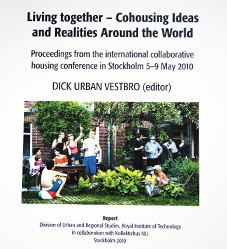Info material
Why are Denmark, Norway and Sweden so different in terms of cohousing?
This question has led Bertil Egerö to search for explanations. In his paper Puzzling patterns of co-housing in Scandinavia (unpublished, 2014) he searches the roots of the differences in the wider spheres of national cultures, institutions and policies.
The paper Four Decades of Swedish Cohousing - What Chances of a Real Take-off
was written and presented by Bertil Egerö at a European conference in Tours, 12-13 March 2012. Egerö discusses the prospects of a wider acceptance of cohousing in Sweden against experiences gathered of the history of the Swedish cohousing movement and its achievements so far. He concludes by underlining the strength of constraints in politics, institutions and culture as impediments to a real take-off.
-
A broad overview of cohousing models in five countries
-
 Read John Killock's report about the historical development and present situation for cohousing in Denmark, the Netherlands, Sweden, USA and the UK. The 193 pages report is richly illustrated and shows a large number of design models. It also makes interesting comparisons between the five countries. The main focus is on senior cohousing, but the book also describes many projects for mixed ages. The report has been made possible through a grant from the Royal Institute of British Architects.
Read John Killock's report about the historical development and present situation for cohousing in Denmark, the Netherlands, Sweden, USA and the UK. The 193 pages report is richly illustrated and shows a large number of design models. It also makes interesting comparisons between the five countries. The main focus is on senior cohousing, but the book also describes many projects for mixed ages. The report has been made possible through a grant from the Royal Institute of British Architects.
-
Cohousing in Sweden, history and present situation
History of cohousing – internationally and in Sweden Collaborative housing (here also called cohousing) has a long and fascinating history. In different periods various models for more neighbourly housing with shared services have been launched. These models have been motivated sometimes as social and political visions and sometimes as practical solutions to the needs of day-to-day life. The most important goals have been to share responsibilities fairly between men and women, to know and work with those who live nearby, and to have access to shared facilities. This article describes the main characteristics and antecedents of cohousing internationally and in Sweden.
Here you can learn more: Cohousing in Sweden, a document written by the former chairman of Kollektivhus NU, Dick Urban Vestbro, in 2014.
-
Reports from the EU-funded project CoElderly now available
You can now download the three first reports within the project CoElderly. This project focuses on education for self-management of communal housing for the elderly and persons with disfunctions. The reports are written by Consorzio Cooperative Sociali in Italy, Fundacja Aktywny Senior in Poland, Cohousing UK and Kollektivhus NU, Sweden. The reports are the following:
- Newsletter 1
Newsletter 2
Newsletter 3
Newsletter 4 -
Living together – Cohousing Ideas and Realities Around the World
In May 2010, the first ever International Conference on Collaborative Housing took place in Stockholm, Sweden, attracting 150 participants from no less than 20 countries. Cohousing Now presents a comprehensive report from the conferense.

The book is an excellent source of material for researchers, housing companies, politicians, activists and non-government organisations interested in how to solve challenges linked to the ageing of societies and other transformations in household structures, how to relate to the problems of urban anonymity and isolation, or how to bring to life the potential of neighbourly cooperation and the search for less unsustainable lifestyles.
The Conference was a joint arrangement by the Swedish association Kollektivhus Nu and the Division of Urban and Regional Studies of The Royal Institute of Technology (KTH), Stockholm.
Read more about the book: Living together (pdf).
The book may be ordered either from: The Division of Urban and Regional Studies, School of Architecture and the Built Environment, the Royal Institute of Technology, Drottning Kristinas väg 30, SE-10044 Stockholm, Sweden or from: kollektivhus.nu@gmail.com
The price of the book is Eur 18 (USD 23, SEK 150) + postage for single copies and Eur 16 (USD 20, SEK 120) + postage when ordering ten copies or more.
-
Presentation/exhibition
Welcome to our presentation (pdf) of Swedish cohousing experiences!
If you want a high-resolution pdf for printing, please send an email to kollektivhus.nu@gmail.com
-
To live in a collaborative housing
Read our brochure (pdf).
-
Contact:
kollektivhus.nu@gmail.com
-
© 2010 Kollektivhus NU
Site made by Karin Råghall